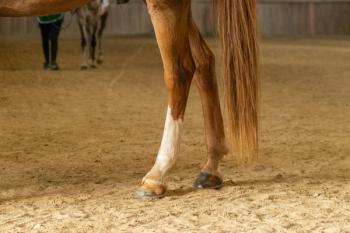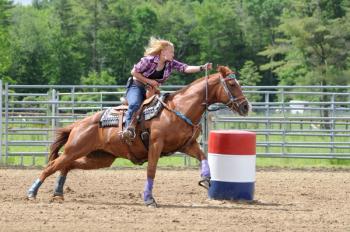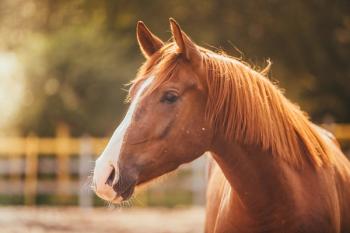
Sleep deprivation is not narcolepsy in horses (Proceedings)
Narcolepsy/cataplexy is extremely rare and breed specific. In this author's opinion sleep deprivation and subsequent deficiencies in paroxysmal and hence recumbent sleep are far more common, and also commonly misdiagnosed as narcolepsy.
Narcolepsy with or without cataplexy and sleep deprivation
Narcolepsy/cataplexy is extremely rare and breed specific. In this author's opinion sleep deprivation and subsequent deficiencies in paroxysmal and hence recumbent sleep are far more common, and also commonly misdiagnosed as narcolepsy. Narcolepsy is associated with excessive sleepiness and pathologic manifestations of Rapid Eye Movement Sleep (REM) which occurs in periods of paradoxical sleep AND includes loss of motor function.
Figure 1: A chronically sleep deprived horse. On the left, he is diffusely drowsy. Rather than arousing and lying down, he ends in the position on the right for a few seconds and then wakes to cycle over and over again. He will not lie down.
Excessive drowsiness secondary to recumbent sleep deprivation
Horses need a period of recumbent sleep that can be avoided for several days, but eventually must be taken. Recumbent sleep deprivation is manifested as diffuse drowsiness that moves to early slow wave sleep. Partial collapse follows with sudden arousal. However, instead of lying down the cycle repeats itself. The author places cases of Excessive drowsiness into 4 categories.
1. Pain associated Excessive Drowsiness is defined as those cases where horses do not lie down because it is painful to do so, or it is painful to rise or both. Most often these horses have musculoskeletal issues that create pain or mechanical difficulties on attempts at recumbency or rising to stand or both. Horses can also have episodes with thoracic or abdominal pain that is elicited with recumbency or on attempting to stand.
2. Environmental insecurity associated Excessive Drowsiness, is the condition where horses do not lie down because they are psychologically uncomfortable doing so, because horses will only lie down when they are environmentally comfortable. One can assume that this stems from horses as prey and herd behavior. The author has managed several horses with this syndrome by adding a friend (especially adding a mare) to the pasture or stall, or moving the horse to an area where there are more horses, or removing an aggressive horse from a group where several horses may have the problem. This would also include horses in an insecure environment that may just require a larger stall or paddock, or those horses near loud harassing noise, like fireworks, or speedways.
3. Monotony induced Excessive Drowsiness is best exemplified by the horse in crossties being braided that begins to lower its head to the point of near collapse. This is assumed to be the horse moving from slow wave to paradoxical sleep. This may also be seen more commonly at the odd hours that owners tend to braid horses. The horse is often very comfortable in its environment and near sleep is simply induced.
4. Dominance Displacement Excessive Drowsiness, is the condition where a gelding acts as a constant dominant mare until a true dominant mare is placed into the herd. These horses are often seen as aggressive towards other horses. Episodes begin when the horse is stalled, or otherwise removed from the herd.
Sleep
Sleep, patterns of sleep, and sleep behavior are, in general, not areas of concern in veterinary medicine. There is a traditional lack of concern with sleep and its impact on performance and clinical outcome. That is difficult to understand in light of the need for sleep's essential, sustaining, recuperative physiology in other species. Sleep is commonly defined as a period of immobility in which individuals seem unresponsive to their environment. Sleep now is accepted as a behavior with clear physiologic necessities that are not understood, but when lacking have clear dysfunctional impact. As a component of the day, it is estimated that horses require 2 hours of drowsiness, 3 hours of slow wave sleep, less than 1 hour of paradoxical sleep with 4 hours of total sleep time.4 There is no definitive explanation for the necessity or the function of sleep in horses, or for that matter in all other species.
Influences on sleep
Sleep can be altered by environmental and physical factors. Horses assume recumbency in a comfortable environment. When moved to an uncomfortable environment, sleep can be adversely effected for several days. When subjects are put outdoors, it may be 1 or 2 days before they first lay down. This habituation may be socially facilitated. If 1 horse is familiar with the new environment, it will lie down and the others will follow. It is felt that the dominant animal is usually the first to lie down. Observing wild ponies indicated that recumbent resting behavior occupies 16% of a horse's time. This behavior reaches a peak between 12:00 AM to 4:00 AM. All ponies were never seen to be lying down simultaneously. However, this contrasts with a study with feral Appaloosa horses where the entire herd was seen recumbent at one time during each day.
Summary
In the 20 year collection of cases of sleep deprivation, it has been unusual to manage a case with drugs, other than pain relief. An understanding of sleep, sleep deprivation and narcolepsy makes for a clearer more successful diagnosis and management plan.
References
Lunn DP, Cuddon PA, Shaftoe S, Archer RM. Familial occurrence of narcolepsy in miniature horses. Equine Vet J. 1993 Nov;25(6):476-7.
Dallaire A. Rest behavior. Vet Clin North Am Equine Pract. 1986 Dec;2(3):591-607.
Ruckebusch, Y .: The relevance of drowsiness in the circadian cycle of farm animals. Anim. Behav., 20:637-643, 1972.
15. Keiper, R. R., and Keenan, M. A.: Nocturnal activity patterns of feral ponies. J. Mammal., 61(1):116-118, 1980.
Stebbins, M. C.: Social organization in free-ranging Apaloosa horses. Unpublished M.S. Thesis. Pocatello, Idaho State University, 1974.
Newsletter
From exam room tips to practice management insights, get trusted veterinary news delivered straight to your inbox—subscribe to dvm360.




